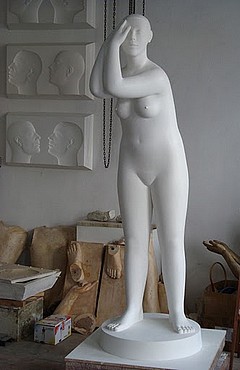
The piazza of the National Theatre was enlivened by the statue Morning by Jiří Středa
 |
| author: Jiří Středa |
"The piazzetta is a beautiful space where sculptures belong. It's good to try it out," Středa told ČTK today, according to whom the exterior is more interesting for sculptures and plastic works than a closed gallery space. "Large sculptures naturally belong outdoors," added the author, whose sculpture of a naked man titled What We Know adorned the courtyard of the National Theatre last year.
At the Academy of Sciences, six of Středa's sculptures are on display. The fifty-six-year-old artist made three sculptures from plaster, one from bronze, and two from stone. "Life-sized sculptures, that's bronze for us. But this here is fragility, vulnerability in solid form, this is typical Středa," curator Dušan Brozman stated at the opening.
Středa's work draws upon the Greek ideal of the human form, which he transforms based on experiences with minimalism and sometimes even grotesque into his own interpretation. His smooth and mostly white sculptures also speak through body language and gestures. Each of Středa's sculptures captures an important moment or thought, such as surprise, hesitation, fear, or expectation.
Ancient patterns also inspire the artistic style that emerged in the 17th century in France - classicism. It is from this that Středa draws inspiration. "Classicism influences me a lot. And all periods of classicism, not just the 19th century," the sculptor told ČTK.
Classicism emphasized sober reason, moderation, and clear, regular order. A new wave of classicism was brought about by the French Revolution and the rise of Napoleon. The artistic movement re-emerged in the 20th century when classicist architecture became the style of dictatorial and totalitarian regimes.
The exhibition at the Academy of Sciences will last until August 3rd.
The English translation is powered by AI tool. Switch to Czech to view the original text source.
0 comments
add comment










